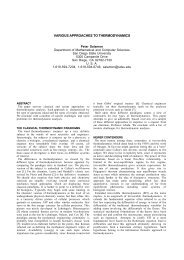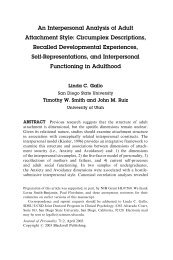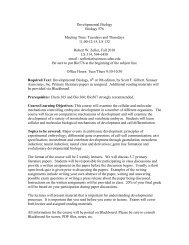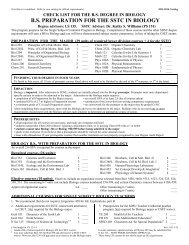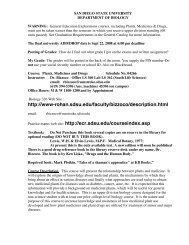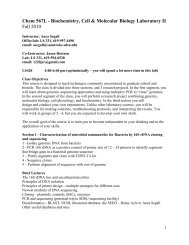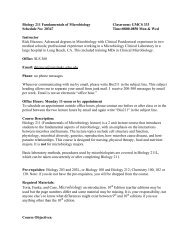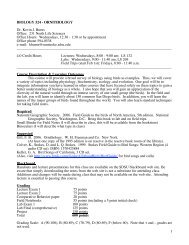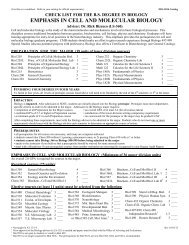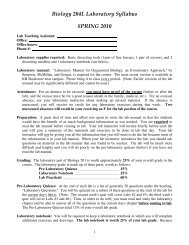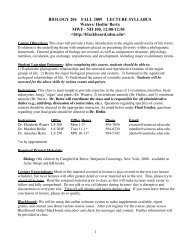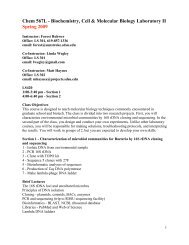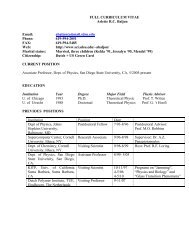sciences review web 2003 - The College of Sciences - SDSU
sciences review web 2003 - The College of Sciences - SDSU
sciences review web 2003 - The College of Sciences - SDSU
Create successful ePaper yourself
Turn your PDF publications into a flip-book with our unique Google optimized e-Paper software.
<strong>College</strong> <strong>of</strong> <strong>Sciences</strong><br />
Dean: Dr. Thomas R. Scott<br />
Message from the Dean: Dr. Thomas R. Scott<br />
year ago I began this message with the words<br />
A “we have celebrated a year <strong>of</strong>....” Anyone who has<br />
followed the financial reversal in California will know<br />
that the past year has not been one <strong>of</strong> celebration.<br />
What positive signs can we find in this time <strong>of</strong> austere<br />
budgets and increasing costs? In fact, a gratifying<br />
number. Our physical facilities continue to improve, we<br />
are having an ever-greater national impact on scientific<br />
research, we serve a large and improving student body<br />
and are integral to the economic success <strong>of</strong> San Diego’s<br />
technology-based community.<br />
Our physical plant is undergoing a transformation. <strong>The</strong><br />
dismal if serviceable Chemistry-Geology building (CG)<br />
has been reborn as an attractive <strong>of</strong>fice building housing<br />
the departments <strong>of</strong> mathematics, computer <strong>sciences</strong> and<br />
the department <strong>of</strong>fices <strong>of</strong> chemistry and geology, plus<br />
advising and the Dean’s <strong>of</strong>fices. <strong>The</strong> new name is notably<br />
uncreative-geology, mathematics and computer science<br />
(GMC)-but may be only temporary. Members <strong>of</strong> the<br />
Dean’s staff are particularly pleased to have vacated the<br />
temporary trailer that housed us for twelve years in favor<br />
<strong>of</strong> space that has, among other amenities, plumbing. <strong>The</strong><br />
noble triple-wide trailer will not be retired, but will be<br />
taken to Santa Margarita Ecological Reserve, the largest<br />
<strong>of</strong> our Field Stations, where it will serve as housing and<br />
<strong>of</strong>fice space for our ecologists.<br />
<strong>The</strong> five-story BioScience Center that will occupy the<br />
space upon which the Dean’s trailer stood will house our<br />
expanding molecular biology program. <strong>The</strong> basement<br />
will have animal quarters, the first floor, <strong>of</strong>fice space. <strong>The</strong><br />
remaining three floors will accommodate 15 research labs<br />
devoted to the Heart Institute, the Center for Microbial<br />
<strong>Sciences</strong>, the Genomics Center, and the Molecular Biology<br />
Institute. This will become a cynosure <strong>of</strong> research on<br />
cardiovascular disease and a center for addressing the<br />
nation’s concern about bioterrorism. <strong>The</strong> BioScience<br />
Center will emphasize research and graduate trainingtherefore<br />
it is not eligible for State support. Rather, the<br />
$13 million expense must be borne by private concerns.<br />
In December 2002, the <strong>SDSU</strong> Foundation committed $8M<br />
to permit construction to begin. Raising the remainder is<br />
the leading funding priority <strong>of</strong> the <strong>College</strong> <strong>of</strong> <strong>Sciences</strong>.<br />
Construction <strong>of</strong> the Coastal Waters Lab, to be located at<br />
the site <strong>of</strong> the former Naval Training Center on S.D. bay,<br />
has been slowed by city regulations and community<br />
concerns, but should be underway late in <strong>2003</strong>. <strong>The</strong> U.S.<br />
Geological Survey will use a portion <strong>of</strong> the building for<br />
<strong>of</strong>fices, while the research labs <strong>of</strong> our marine ecologists<br />
will occupy the remainder.<br />
<strong>The</strong> Visualization Center that occupies the ground<br />
level <strong>of</strong> the Chemical <strong>Sciences</strong> Lab has continued<br />
to serve as a sophisticated nexus for national<br />
communication. In January <strong>of</strong> this year, the massive<br />
security operations surrounding the Superbowl (played<br />
in Qualcomm Stadium) were run from the Viz Center.<br />
Our computational scientists collaborated with law<br />
enforcement agencies from the federal to local levels to<br />
monitor activity around the game and to plan for possible<br />
emergencies. <strong>The</strong>re were scores <strong>of</strong> remotely operated<br />
cameras around the stadium, microphones concealed<br />
in the surrounding shrubbery programmed to detect<br />
the vibrations created by large bipedal mammals and<br />
chemical sensors in and along the banks <strong>of</strong> the San Diego<br />
River equipped to detect toxins in the water supply. Men<br />
in bio-isolation suits paced near the stadium. A national<br />
network <strong>of</strong> enhanced reality connections was open<br />
before and during the game through which medical<br />
specialists standing by at sites around the country could<br />
monitor, diagnose and direct the treatment <strong>of</strong> victims <strong>of</strong><br />
a mass attack. All information was sent through wireless<br />
connections to the top <strong>of</strong> Qualcomm, from where it was<br />
relayed to an <strong>SDSU</strong> dorm, then by fiber to the Viz Center.<br />
During the game, the screens <strong>of</strong> the Center were alive<br />
with images from 16 cameras and masses <strong>of</strong> audio and<br />
chemical information in real time. <strong>The</strong> day’s only disaster<br />
belonged to the Raiders, but the effort <strong>of</strong> coordinating<br />
our capabilities with those <strong>of</strong> local law enforcers, the FBI,<br />
CIA and the Office <strong>of</strong> Homeland Security taught us lessons<br />
that will serve us well in helping San Diego cope with<br />
emergencies <strong>of</strong> the future.<br />
Research from the <strong>College</strong> <strong>of</strong> <strong>Sciences</strong> reached record<br />
levels in the past year. Our faculty published 368 refereed<br />
articles, 44% <strong>of</strong> them in collaboration with graduate<br />
and undergraduate students in our labs. We won $30<br />
million in external funding for our research, an average<br />
<strong>of</strong> $167,000 per faculty member. This addition to the San<br />
Diego economy is more than double the average salary<br />
and benefits a faculty member earns, and reflects once<br />
more what a valuable contribution our research-oriented<br />
scientists make to the community.<br />
<strong>SDSU</strong> had 43,000 applications for admission this year. Of<br />
these, approximately 30,000 were seeking entry to the<br />
freshman class, and were CSU-eligible. <strong>SDSU</strong> was able<br />
to admit only about 20,000 in anticipation <strong>of</strong> filling an<br />
entering class <strong>of</strong> just over 7000. Those admitted have<br />
an average high school GPA <strong>of</strong> 3.6 and SATs <strong>of</strong> 1089,<br />
making them the best-credentialed group in our<br />
university’s history.<br />
I cannot summarize the past year without addressing<br />
the budget situation that threatens to undo much <strong>of</strong><br />
our progress <strong>of</strong> the past three decades. State support<br />
continues to be the core <strong>of</strong> <strong>SDSU</strong>’s funding, the reliable<br />
flow <strong>of</strong> renewable resources from which we hire<br />
faculty, lecturers, staff, TAs, and from which we derive<br />
basic operating budgets. Upon our state allocation we<br />
overlay federal and philanthropic support that makes<br />
<strong>SDSU</strong> the flagship institution <strong>of</strong> the 23-member CSU<br />
system. Reductions in our state allocations require us<br />
to modify our delivery <strong>of</strong> classes. A number <strong>of</strong> faculty<br />
will have increased teaching assignments, replacing<br />
lecturers in the classroom. Class sizes will rise,<br />
particularly in the lower division where courses will be<br />
<strong>of</strong>fered in larger lecture sections. <strong>The</strong> Women’s Gym<br />
in the department <strong>of</strong> Exercise and Nutrition <strong>Sciences</strong> is<br />
being transformed into a 500+ seat lecture theatre in<br />
which COS will <strong>of</strong>fer introductory courses in chemistry,<br />
biology and psychology beginning this fall. Our tasks<br />
are to sustain our strength through this financial strait,<br />
while continuing to advance in selected areas, notably<br />
biochemistry, molecular biology and computational<br />
<strong>sciences</strong>. We will cope with the reductions <strong>of</strong> <strong>2003</strong>-04<br />
with frugality, efficiency, non-renewal <strong>of</strong> some contracts<br />
and the use <strong>of</strong> university reserves. What awaits us in<br />
2004-05 may be <strong>of</strong> even greater concern.<br />
On the following pages you will find summaries <strong>of</strong> the<br />
events in each <strong>of</strong> our eight departments from the past<br />
year. We encourage you to maintain contact with your<br />
department, and to provide the allegiance and support<br />
that will be necessary if we are to emerge from these<br />
years as a vital teaching and research institution.



